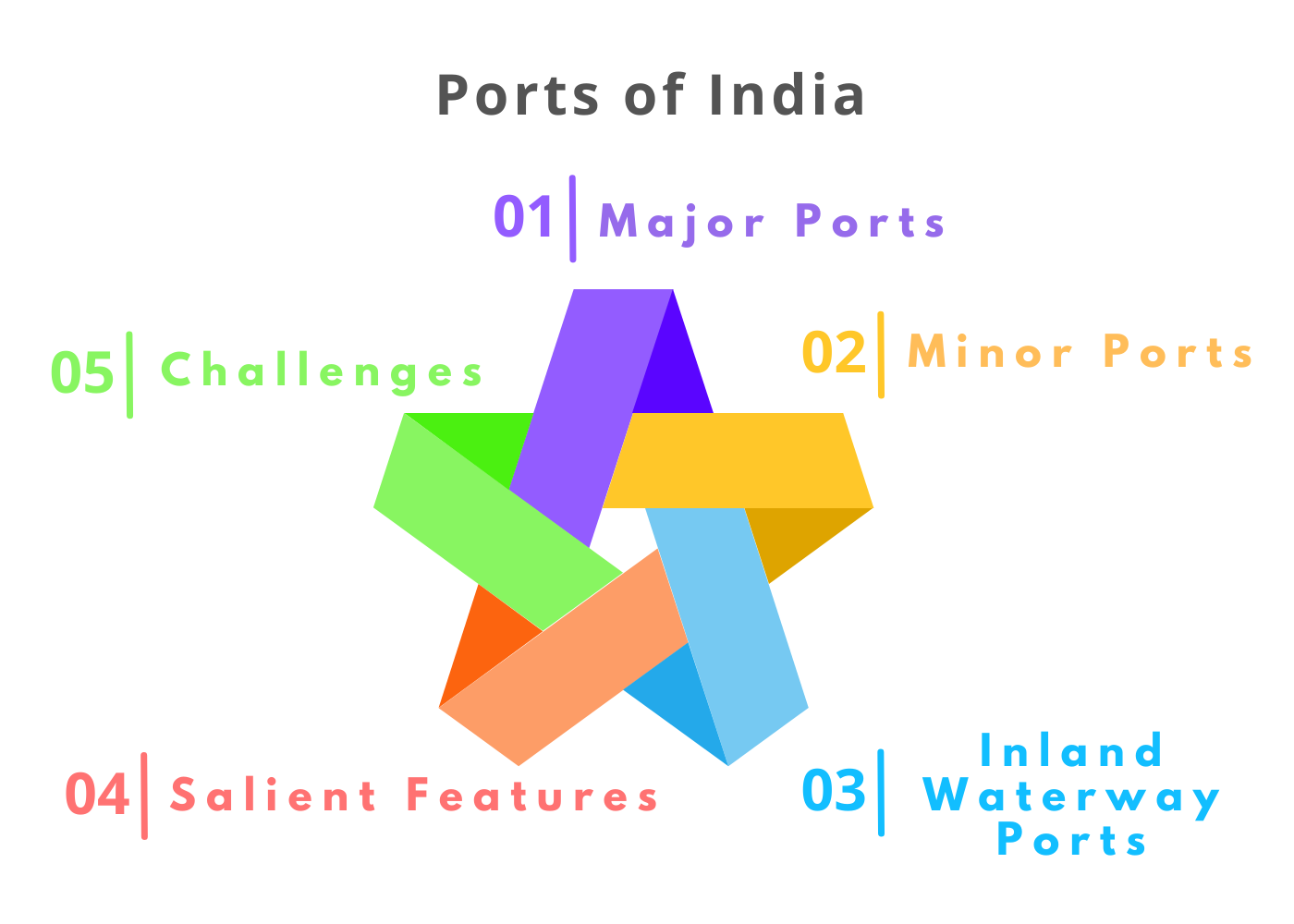Detailed content
Geographical Overview
India, surrounded by the Arabian Sea, the Indian Ocean, and the
Bay of Bengal, boasts a vast coastline of approximately 7,517
kilometers, making it strategically positioned for maritime trade.
The ports of India are distributed along this coastline,
strategically located to facilitate both domestic and
international trade.
Historical Significance
India's maritime history dates back to ancient times, with ports
like Lothal in the state of Gujarat serving as evidence of the
country's early trade connections with Mesopotamia and Egypt. Over
the centuries, various empires, including the Mauryas, Cholas, and
Mughals, developed ports for trade and commerce. However, it was
during the colonial period that the modern port infrastructure
began to take shape under British rule. Ports like Mumbai
(formerly Bombay), Kolkata (formerly Calcutta), and Chennai
(formerly Madras) played crucial roles in British India's trade
with the rest of the world.
Economic Contributions
The ports of India are vital components of the country's economy,
facilitating the movement of goods to and from different parts of
the world. They serve as gateways for international trade,
handling a significant portion of India's total trade volume. The
import and export of goods such as petroleum products, coal, iron
ore, textiles, machinery, and agricultural products contribute
substantially to India's GDP.
Infrastructure Development
In recent decades, India has invested heavily in upgrading its
port infrastructure to meet the growing demands of global trade.
Major port trusts, private players, and public-private
partnerships have played crucial roles in modernizing facilities,
increasing cargo-handling capacities, and enhancing efficiency.
Infrastructure development includes the construction of deep-water
berths, container terminals, mechanized cargo-handling equipment,
and the implementation of advanced technology for port operations
and management.
Port Classification
India's ports can be classified into major ports and minor ports.
Major ports, governed by the Central Government, are managed by
port trusts and are subject to regulations under the Major Port
Trusts Act of 1963. There are currently 12 major ports in India,
including Mumbai, Chennai, Kolkata, and Jawaharlal Nehru Port
Trust (JNPT). Minor ports, on the other hand, are under the
jurisdiction of the respective state governments and cater to
regional trade requirements. They play a significant role in the
development of coastal areas and intra-state trade.
Major Ports
• Mumbai Port: Located on the west coast of India, Mumbai
Port is the largest port in the country by handling over 60
million metric tons of cargo annually. It handles various types of
cargo, including liquid bulk, dry bulk, and containers.
• Jawaharlal Nehru Port Trust (JNPT): Situated in Navi
Mumbai, JNPT is the largest container port in India and handles a
significant portion of the country's containerized cargo. It has
modern container terminals equipped with state-of-the-art
facilities.
• Kolkata Port: Located on the eastern bank of the Hooghly
River, Kolkata Port is one of the oldest ports in India and serves
the eastern and northeastern regions of the country. It primarily
handles bulk cargo, including coal, iron ore, and petroleum
products.
• Chennai Port: Situated on the Coromandel Coast in Tamil
Nadu, Chennai Port is a major hub for container traffic,
automobiles, and general cargo. It has modern facilities for
handling various types of cargo and has witnessed significant
growth in recent years.
• Visakhapatnam Port: Located in Andhra Pradesh,
Visakhapatnam Port is the largest port on the east coast of India.
It handles a diverse range of cargo, including iron ore, coal,
crude oil, and containers, and plays a crucial role in the
country's trade with Southeast Asia.
• Paradip Port: Situated in Odisha, Paradip Port is an
important port for handling bulk cargo, particularly iron ore,
coal, and petroleum products. It has undergone significant
expansion in recent years to accommodate larger vessels and
increased cargo traffic.
• Mormugao Port: Located in Goa, Mormugao Port primarily
handles iron ore exports and serves as a gateway for trade with
countries in the Middle East and Europe.
• New Mangalore Port: Situated in Karnataka, New Mangalore
Port handles various types of cargo, including crude oil,
petroleum products, coal, and containerized cargo. It serves the
hinterland of Karnataka and neighboring states.
• Kandla Port: Located in Gujarat, Kandla Port is the
largest port on the west coast of India and a major hub for trade
with the Gulf countries. It handles various types of cargo,
including petroleum products, chemicals, fertilizers, and
containers.
• Ennore Port: Situated in Tamil Nadu, Ennore Port is a
relatively new port that primarily handles coal, iron ore, and
general cargo. It has modern facilities and is strategically
located to serve the industrial areas of Chennai and the
surrounding regions.
• V.O. Chidambaranar Port (formerly Tuticorin Port):
Located in Tamil Nadu, V.O. Chidambaranar Port is a major
container port on the east coast of India. It handles
containerized cargo, coal, and other bulk commodities and plays a
crucial role in India's international trade.
• Cochin Port: Situated in Kerala, Cochin Port is a major
transshipment hub and handles containerized cargo, liquid bulk,
and dry bulk cargo. It serves as a gateway for trade with the
Middle East, Europe, and East Asia
Future Prospects
• The ports of India are poised for further growth and development
in the coming years. The government's initiatives such as
Sagarmala and Bharatmala aim to enhance port connectivity,
modernize infrastructure, and promote coastal shipping and inland
waterways. Investments in port-led industrialization, logistics
parks, and multi-modal transportation are expected to boost trade
efficiency and competitiveness. Moreover, the development of smart
ports and the adoption of digital technologies are likely to
streamline port operations and improve customer service. • In
conclusion, the ports of India play a crucial role in the
country's economy by facilitating trade, promoting
industrialization, and supporting regional development. With
continued investments in infrastructure and technology, India's
ports are well-positioned to meet the challenges of global trade
and contribute significantly to the country's economic growth and
prosperity.
